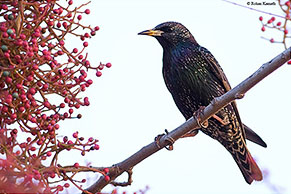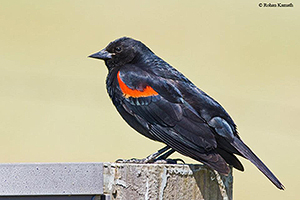Flock Defense |
|
|---|---|

 photograph of a European Starling and a Red-winged Blackbird by Rohan Kamath |
One
of the advantages that animals may obtain by grouping is a
better chance of avoiding predators. Assuming a predator
generally will attack the closest individual, a bird can
reduce its "domain of danger," the area in which it can be
the closest prey to a predator, by joining a flock. Where
there is cover, of course, hiding rather than flocking may
be a more effective predator defense strategy. Simply reducing the domain of danger may not be enough to cause the evolution of flocking behavior, even in open country. Flocking may, in fact, backfire. The flock may be so conspicuous or represent so much potential food that it attracts predators that might otherwise miss or ignore a lone bird. However, there are other possible advantages of flocking. For instance, in some situations being in a flock may reduce the amount of time each bird must spend watching for predators, and thus increase the amount of time it has for feeding or other activities. Suppose a certain bird must spend half of its time feeding in order to survive, and can watch for predators the other half. A cat might sneak up on the bird by moving only when the bird was busy feeding. If two birds forage together, and they feed and look out at random, one bird or the other will be looking out three-fourths of the time. A little arithmetic shows that ten birds feeding together will have at least one individual watching for predators 99.9 percent of the time. This bit of theory is supported by results from an interesting experiment with |
|
Laughing Doves (also called Senegal Turtledoves, a species
from Africa and south-central Asia that is invading Europe
and has been introduced into western Australia).
Experimenters used bait to attract natural flocks of the
doves and then "flew" a model hawk down a slanting wire
toward them. The entire procedure was filmed, and the
reactions of the birds analyzed in slow motion. When flock
sizes were between 4 and 15 birds, the size of the flock and
the speed with which they became aware of the hawk and fled
were directly related: the more birds, the quicker the
reaction. Flocks of less than 4, however, reacted even
faster than flocks of 4 to 15; but because they were always
skittish and had many "false alarms," they did not feed
well. In contrast, flocks of more than 15 birds had slower
reaction times; often because they became engrossed in
battles over the food. Similar results have been obtained
from observations of falcons attacking wintering shorebirds
on a California estuary. Hunting success was high when
solitary shorebirds were the prey and when large flocks were
attacked. Success was low when flocks of intermediate size
were the targets. So, at least over an intermediate range of flock sizes, the notion that more eyes are better than fewer seems to hold. In that range, larger flocks may detect predators more easily. Furthermore, flock members may reduce their chances of being eaten once the predator is detected. The sudden flight of large numbers of birds, or their simultaneous calls, may temporarily bewilder a predator and allow the flock to escape. It may also be more difficult for a predator to pick a victim from a wheeling flock than to catch a lone individual. This phenomenon is well known to the duck hunter who blasts away at an entire flock and does not hit a single bird. Finally, flocks of birds may turn the tables on predators. Both European Starling and Red-winged Blackbird flocks have been observed to attack their attackers and force them into water or onto the ground. |
|
| SEE:
Temperature Regulation and Behavior;
Head-scratching. Copyright ® 1988 by Paul R. Ehrlich, David S. Dobkin, and Darryl Wheye. |
|